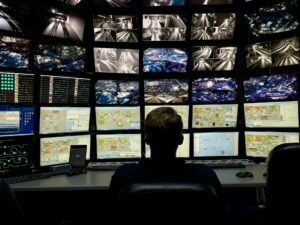The Part Artificial Intelligence Plays in the Identification and Prevention of Misinformation on the Internet

The Part Artificial Intelligence Plays in the Identification and Prevention of Misinformation on the Internet
The digital era has made knowledge more readily available than it has ever been before, but it has also produced an environment that is ripe for the spread of false information. The distribution of material that is either false or misleading may occur swiftly via social media platforms, news websites, and messaging apps; this can have an impact on public opinion, political results, and social behavior. Artificial intelligence (AI) is rapidly becoming into an essential instrument in the battle against misinformation that is distributed over the internet. It is assisting platforms, governments, and users in the process of identifying, flagging, and preventing the proliferation of material that is designed to deceive.
1. Comprehending the Phenomenon of Misinformation on the Internet
The term “online misinformation” refers to information that is inaccurate or misleading that is spread over the internet, whether it is done purposefully or accidentally. There are a variety of different shapes that it may take, such as fabricated news stories, deepfakes, photographs that have been edited, films that have been modified, and social media postings that include misinformation. Democracy, the health of the general population, and social stability are all threatened by the fact that it is spreading so quickly.
2. Artificial intelligence (AI) is able to detect misinformation using a variety of methods.
One of the most common approaches is to use machine learning algorithms to analyze data and identify patterns that are indicative of misinformation. These algorithms are trained using large datasets of both accurate and inaccurate information, which allows them to learn to distinguish between the two types of data. Another approach that is often used is to use natural language processing (NLP) techniques to analyze text and identify patterns that are indicative of misinformation. NLP techniques are trained using large datasets of text, which allows them to learn to identify patterns that are associated with misinformation. In addition to these two approaches, there are a variety of other methods that may be used to detect misinformation, such as using AI to analyze images and videos.
Artificial intelligence (AI) systems make use of machine learning, natural language processing (NLP), and computer vision in order to assess information on the internet for signs that it is not truthful. Algorithms are capable of detecting discrepancies in text, identifying pictures or videos that have been edited, and assessing the authenticity of sources based on behavioral patterns and historical data.
3. Fact-Checking on a Large Scale
The pace at which material is distributed online is too fast for manual fact-checking, which is a time-consuming process. Artificial intelligence (AI) is of great assistance to human fact-checkers because it is able to quickly scan through massive amounts of text, including social media postings and news stories, and identify any information that might possibly be deceptive, which it then flags for review. This facilitates the faster verification and distribution of information that is correct.
4. Detection of Deepfakes
One of the most critical challenges we have is dealing with deepfakes, which are synthetic media that seem very realistic and are made using artificial intelligence (AI). In order to determine whether or not a video has been edited, detection techniques that are driven by artificial intelligence (AI) investigate discrepancies in face movements, audio, and metadata. If we want to continue trusting visual material on the internet, we must have this technology.
5. Predictive analysis of the spread of misinformation
Artificial intelligence is capable of evaluating user behavior, engagement metrics, and sharing trends in order to forecast how disinformation will potentially spread throughout social networks. Platforms are able to take preventive actions, such as restricting the reach of dubious material or notifying users before disinformation spreads like wildfire, thanks to the usage of these predictive models.
6. Improving the Oversight of Social Media
Platforms that host social media sites use artificial intelligence (AI) in order to automatically detect or delete any information that constitutes a violation of the criteria established by the community. Artificial intelligence (AI) has the ability to identify organized disinformation operations, spam, and propaganda, which may help to prevent the broad dissemination of false information, while at the same time maintaining freedom of speech.
7. Customized Alerts and Educational Opportunities
Artificial intelligence (AI) has the ability to offer consumers with notifications that are tailored to them when they come across material that has the potential to be deceptive. In addition, artificial intelligence-powered applications have the ability to educate users about disinformation, which may improve digital literacy and assist people in making better educated judgments about what to believe on the internet.
8. Providing Assistance to Journalists and Researchers
When it comes to evaluating trends, recognizing false narratives, and pinpointing the origin of disinformation, journalists and academics are assisted by artificial intelligence (AI). Artificial intelligence (AI) enables experts in the media industry to react efficiently and provide reliable reports by providing them with data-driven insights.
9. Difficulties and Limitations
Artificial intelligence (AI) is not without its limitations, even if it has the potential to be a powerful tool. It is possible that algorithms will have difficulty dealing with context, humor, or new methods of spreading disinformation. Furthermore, biases in artificial intelligence (AI) models might result in inaccurate flagging. Over-reliance on AI without human supervision could compromise accuracy and fairness in the long run.
10. Considerations Regarding Ethics
Maintaining a balance between the identification of disinformation and the protection of freedom of expression is a matter of great importance. In order to guarantee that content moderation does not become too restrictive or discriminating, it is necessary for artificial intelligence systems to be open, responsible, and auditable.
11. The Future of Artificial Intelligence in the Fight Against Misinformation
In the future, as artificial intelligence technology continues to develop, computers will be able to identify disinformation with greater accuracy and in real time. This will be possible across a variety of languages and media formats. The reliability and efficacy of attempts to prevent disinformation from spreading will be improved by integration with blockchain verification, real-time fact-checking, and collaborative human-artificial intelligence systems.
The use of artificial intelligence (AI) is becoming an increasingly important weapon in the fight against the spread of disinformation on the internet. AI contributes to the preservation of the integrity of information that is available on the internet by identifying misleading material, anticipating the extent of its dissemination, providing assistance to human fact-checkers, and educating users. Although obstacles and ethical issues persist, the appropriate use of artificial intelligence (AI) has the potential to considerably lessen the effect of disinformation and foster the development of a more knowledgeable digital society.




